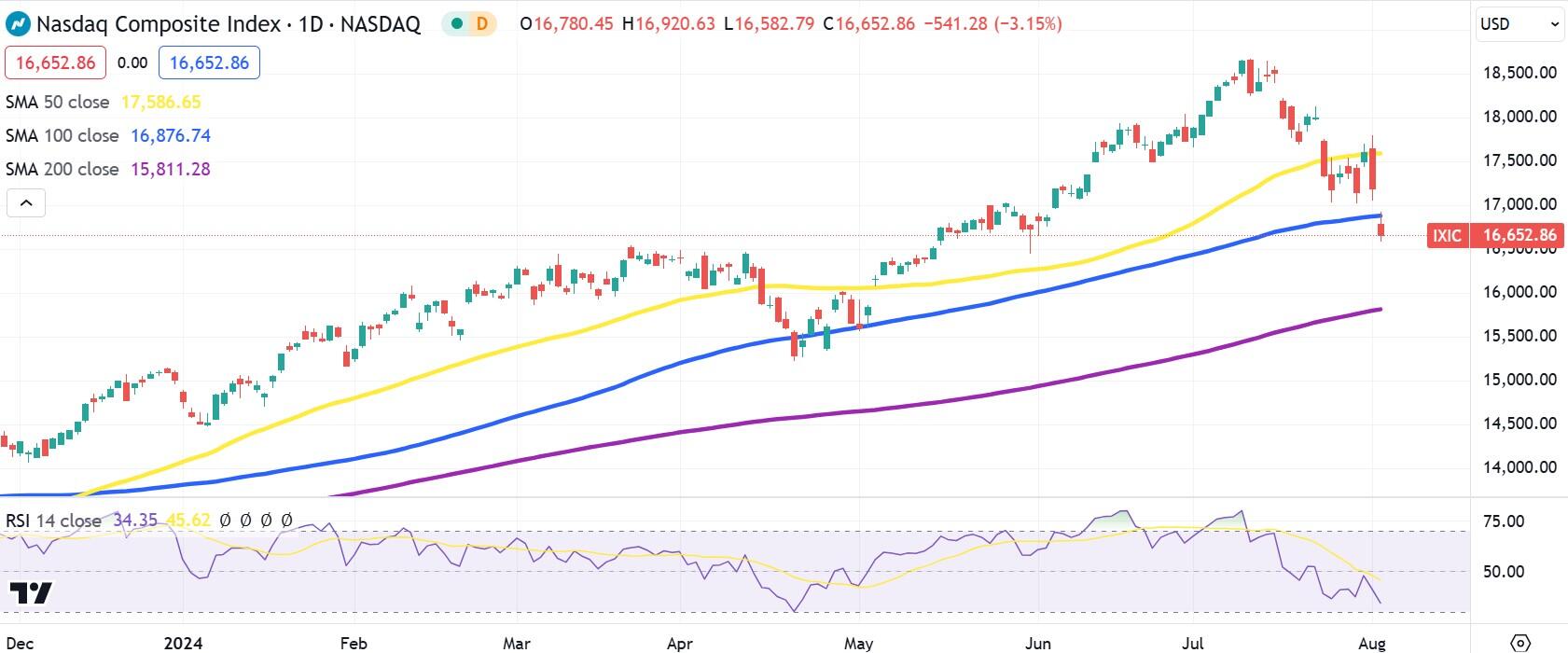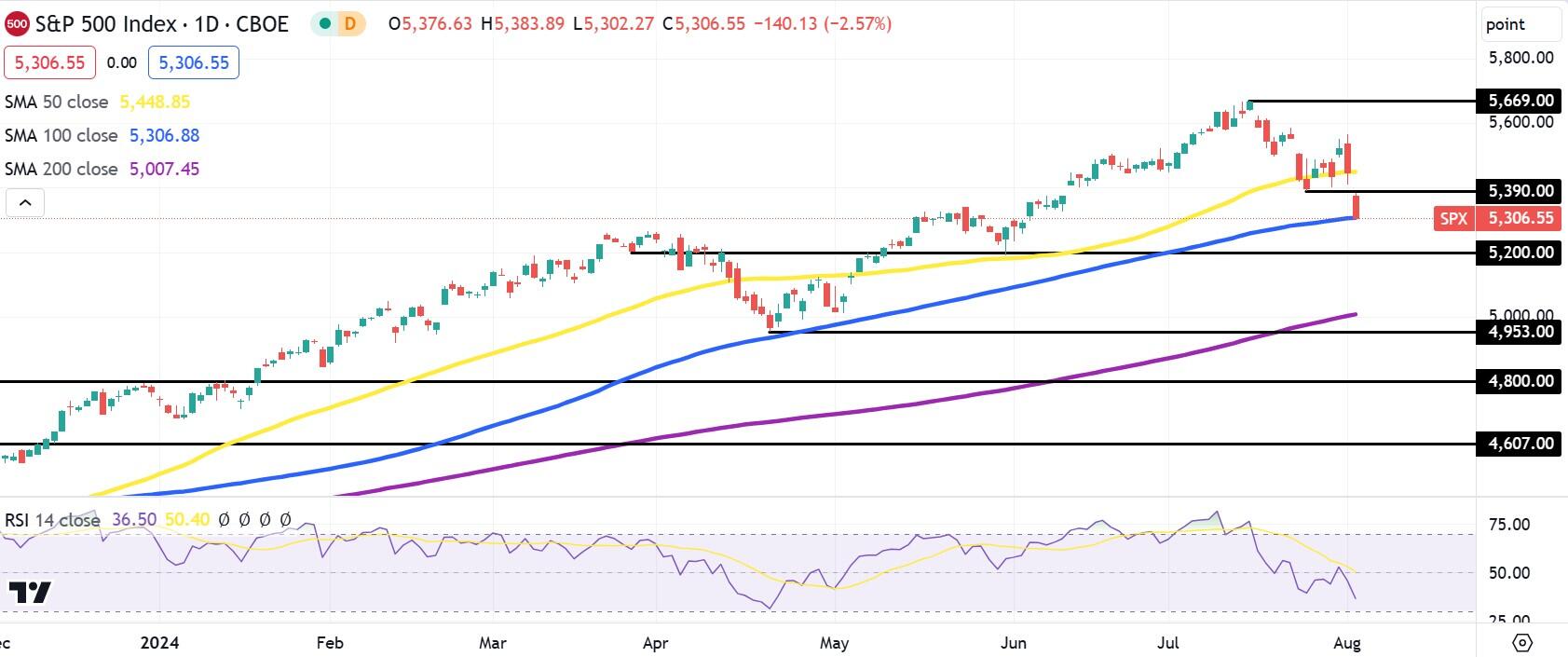- US economy adds 114K jobs in July, well below Wall Street expectations.
- US indices reel on news as Unemployment rises to 4.3%.
- Market now expects three interest rate cuts by Fed this year, 50 bps cut in September.
- Elliot Management calls AI narrative "overhyped".
The stock market pullback that began in the latter half of July is pumping the brakes full force on Friday after US Nonfarm Payrolls for last month surprised to the downside. With Wall Street expecting an already low figure of 175K, US payrolls added just 114K positions in July, and June’s figures of 206K new jobs was revised down to 179K. The Unemployment Rate rose from 4.1% to 4.3%.
The market has taken this as a sign that the US economy is throttled for a harder landing than initially expected. On the good side, investors are finally expecting three interest rate cuts at the remaining Federal Reserve (Fed) meetings in September, November and December. What’s more, the market now expects a 50-basis-point cut at the September meeting, whereas just yesterday the consensus was 25 bps.
The NASDAQ is in for one of its worst showings in years as the tech-heavy index pulls back as much as 3.4% in the morning session. The S&P 500 is down 2.5%, and the Dow Jones contracts 1.8% at the time of writing.
S&P 500, NASDAQ news
All the bright spots in the summer narrative are now being discarded. Hedge fund Elliot Management released an editorial in The Financial Times arguing that the artificial intelligence (AI) theme is “overhyped”.
The mega cap tech stocks like Microsoft (MSFT), Meta Platforms (META) and Amazon (AMZN) are also on the verge of reducing their supercycle of buying Nvidia’s (NVDA) AI-focused chips, according to Elliot, which should put downward pressure on the overall market.
Elliot also complained that AI was not cost-efficient enough to merit the current valuation of many of these AI stocks, which should lead to a pullback in valuations.
A poor third-quarter outlook led Intel (INTC) to slash its workforce by 15% and forgo its dividend, which it had paid consecutively for 31 years. Super Micro Computer (SMCI) and Amazon both dropped around 10%, and Nvidia was down about 5% at the time of writing.
As if the timing couldn’t be worse, the US Justice Department launched a probe into Nvidia’s business practices. Advanced Micro Devices (AMD) is said to have complained about Nvidia abusing its domination of the AI chip industry, and other AI startups have made formal complaints as well.
One specific complaint is that Nvidia has threatened customers who also buy products from its rivals. The threats come from the belief that Nvidia will reduce their allotment of their top-of-the-line chips to customers who buy from other shops. Another issue surrounds Nvidia supposedly bundling its products in anti-competitive ways. Nvidia is currently thought to control about 80% or more of the AI chip market.
Nvidia denied the allegations. "We compete based on decades of investment and innovation, scrupulously adhering to all laws, making NVIDIA openly available in every cloud and on-prem for every enterprise, and ensuring that customers can choose whatever solution is best for them," the company founded and run by CEO Jensen Huang said in a statement.
Semiconductor stocks FAQs
A semiconductor is a term for various types of computer chips. Officially called semiconductor devices, these computer chips rely on semiconductor materials like silicon and gallium arsenide to process the electrical current that produces the modern world of computing. They come in many shapes, sizes, enhancements and configurations such as diodes, transistors and integrated circuits to more complicated applications like DRAM memory, simple processors and even GPUs.
First, there are the pure chip designers, such as Nvidia, AMD, Broadcom and Qualcomm. These companies use sophisticated software to design and test chips. Second, there are the equipment manufacturers that provide the machines necessary to build computer chips. These include ASML and Lam Research. Then, there are foundries that manufacture the chips. These include Taiwan Semiconductor and GlobalFoundries. Last of all are the integrated device manufacturers who design their own chips and additionally manufacture themselves. These include Samsung and Intel.
It is the observation that the number of transistors in an integrated circuit doubles every two years. The “law” is named after Gordon Moore, who founded Fairchild Semiconductor and later Intel. The doubling is possible due to the shrinking size of process nodes or parts in the computer chip. In 1971 the advanced commercial manufacturing had reached 10 microns in width. In 1987 semiconductor technology had advanced to 800 nanometers in width. By 1999, this process had moved to 180 nanometers. By 2007, the size had dropped to 32 nanometers, and this fell all the way to 3 nanometers in 2022, which is close to the size of human DNA.
In 2022, the global semiconductor industry had revenues just under $600 billion. In total, the industry shipped 1.15 trillion semiconductor units in 2021. The leading nations involved in the semiconductor supply chain are Taiwan, the United States, China, the Netherlands, South Korea, Japan and Israel.
NASDAQ, S&P 500 charts
The NASDAQ Composite has broken through its 100-day Simple Moving Average (SMA). It now looks like it may reach for support at the 200-day, which it hasn't grazed . Some support exists at the May 31 low of 16,445. Then there is the 200-day SMA at 15,811 and the April 19 range low of 15,222.
NASDAQ daily chart
The S&P 500 is reacting somewhat better and has discovered support at the 100-day SMA. Still, the odds are on for it to drop back to 5,000, where it found support in April. Granting that level more significance is the fact that the 200-day SMA is sitting just above 5,000.
S&P 500 chart
Information on these pages contains forward-looking statements that involve risks and uncertainties. Markets and instruments profiled on this page are for informational purposes only and should not in any way come across as a recommendation to buy or sell in these assets. You should do your own thorough research before making any investment decisions. FXStreet does not in any way guarantee that this information is free from mistakes, errors, or material misstatements. It also does not guarantee that this information is of a timely nature. Investing in Open Markets involves a great deal of risk, including the loss of all or a portion of your investment, as well as emotional distress. All risks, losses and costs associated with investing, including total loss of principal, are your responsibility. The views and opinions expressed in this article are those of the authors and do not necessarily reflect the official policy or position of FXStreet nor its advertisers. The author will not be held responsible for information that is found at the end of links posted on this page.
If not otherwise explicitly mentioned in the body of the article, at the time of writing, the author has no position in any stock mentioned in this article and no business relationship with any company mentioned. The author has not received compensation for writing this article, other than from FXStreet.
FXStreet and the author do not provide personalized recommendations. The author makes no representations as to the accuracy, completeness, or suitability of this information. FXStreet and the author will not be liable for any errors, omissions or any losses, injuries or damages arising from this information and its display or use. Errors and omissions excepted.
The author and FXStreet are not registered investment advisors and nothing in this article is intended to be investment advice.
Recommended content
Editors’ Picks

EUR/USD bounces off lows, retests 1.1370
Following an early drop to the vicinity of 1.1310, EUR/USD now manages to regain pace and retargets the 1.1370-1.1380 band on the back of a tepid knee-jerk in the US Dollar, always amid growing optimism over a potential de-escalation in the US-China trade war.

GBP/USD trades slightly on the defensive in the low-1.3300s
GBP/USD remains under a mild selling pressure just above 1.3300 on Friday, despite firmer-than-expected UK Retail Sales. The pair is weighed down by a renewed buying interest in the Greenback, bolstered by fresh headlines suggesting a softening in the rhetoric surrounding the US-China trade conflict.

Gold remains offered below $3,300
Gold reversed Thursday’s rebound and slipped toward the $3,260 area per troy ounce at the end of the week in response to further improvement in the market sentiment, which was in turn underpinned by hopes of positive developments around the US-China trade crisis.

Ethereum: Accumulation addresses grab 1.11 million ETH as bullish momentum rises
Ethereum saw a 1% decline on Friday as sellers dominated exchange activity in the past 24 hours. Despite the recent selling, increased inflows into accumulation addresses and declining net taker volume show a gradual return of bullish momentum.

Week ahead: US GDP, inflation and jobs in focus amid tariff mess – BoJ meets
Barrage of US data to shed light on US economy as tariff war heats up. GDP, PCE inflation and nonfarm payrolls reports to headline the week. Bank of Japan to hold rates but may downgrade growth outlook. Eurozone and Australian CPI also on the agenda, Canadians go to the polls.

The Best brokers to trade EUR/USD
SPONSORED Discover the top brokers for trading EUR/USD in 2025. Our list features brokers with competitive spreads, fast execution, and powerful platforms. Whether you're a beginner or an expert, find the right partner to navigate the dynamic Forex market.




